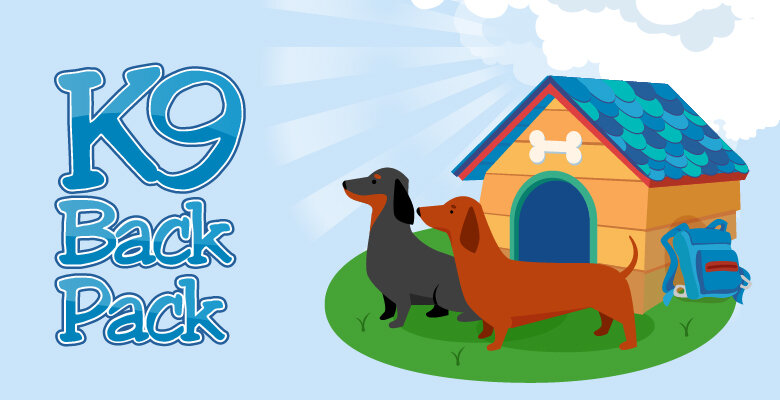Canine Blindness
Who turned out the lights?
There are many conditions that can cause sudden or progressive blindness in dogs. Some of them are:
Progressive Retinal Atrophy, or PRA
Sudden Acquired Retinal Degeneration Syndrome, or SARDS
Glaucoma
Progressive Retinal Atrophy (PRA)
Progressive Retinal Atrophy, or PRA, is a degeneration of the canine retina that leads to blindness. In most cases, the first symptoms appear between 6-8 years of age and both eyes are affected.
PRA is a genetic condition so it is extremely important that dogs affected are not bred.
The earliest symptom of this disease is night blindness: the dog could bump into things in darker rooms, might refuse to move or will do it gingerly. If you try to play fetch in a room or yard that doesn’t have too much light the dog will miss the ball.
To confirm PRA, the dog must undergo a test called Electroretinogram, performed by a veterinary eye specialist. In that test, the specialist will measure how well the retina can read small electric impulses and transmit the information. This test is so sensitive that it could detect PRA even before the dog starts showing obvious symptoms of vision loss.
There is presently no cure for PRA or evidence that any supplement or medicine can make a difference in the outcome. However, PRA is painless and not life threatening.
Sudden Acquired Retinal Degeneration Syndrome (SARDS)
Sudden Acquired Retinal Degeneration Syndrome, or SARDS, is a degeneration of the canine retina that is acute. The dog is suddenly blind (within just a few days or even overnight) and there are no apparent trigger factors (trauma, toxins, etc.).
Blood and urine testing in dogs with sudden blindness is important to rule out other conditions that might be the ultimate cause of the problem. Blood work might reveal Cushing’s syndrome, in which case the disease must be treated, but vision might not be restored.
Diagnosis of SARDS requires, aside from the above mentioned tests, intraocular pressure measurement and an electroretinogram.
If the electroretinogram shows that the retina is functioning correctly, then the diagnosis is not SARDS.
If the electroretinogram is abnormal and the intraocular pressure is normal, then SARDS is the most probable condition present and cause of blindness.
Glaucoma
Glaucoma is a condition in which the intraocular pressure is elevated in one or both eyes.
There are two kinds of Glaucoma: Primary and Secondary.
Primary Glaucoma is caused due to the inability of the eye to drain its fluids.
Secondary Glaucoma is due to another condition, such as an infection or trauma, that causes the eye’s pressure to increase. Secondary Glaucoma could be linked to conditions such as Cushing’s and Diabetes, so it is extremely important to rule them out or treat them if diagnosed.
Glaucoma can be medically managed by using eye drops, sometimes intravenous medicines and constant monitoring. However, an acute case can cause the eye to bulge, headaches, fear of light, and serious pain. In some cases in which the Glaucoma cannot be medically managed, the dogs can benefit from the removal of the affected eye if the intraocular pressure is not controlled and the dog is in constant pain.
In some cases, one or two years later the other eye might start showing symptoms of Glaucoma too.
My dog is blind. Now what?
When dogs are born the first thing they do is smell their mother. Then they taste her milk. A couple of days later they are able to feel. Later on their ears open. And lastly, their eyes see the light for the first time.
Sight is the last of the senses to develop and is the sense dogs probably need less to survive and be happy. So if your dog goes blind, don’t worry. Your dog can be perfectly happy and in a few weeks it can totally adapt.
In some cases in which the loss of sight is gradual, owners may not have even noticed their dogs are already blind until they move a piece of furniture or leave a box in a hall, and the dog suddenly bumps into it.
Blind dogs can adapt SO WELL that they can even play fetch like any normal dog.
Don’t believe me? Check out Chica´s video:
http://wtvr.com/2012/11/08/watch-dog-with-no-eyes-has-uncanny-fetching-skills/
And Myron’s: http://www.youtube.com/watch?v=lP3tV9netQY
So… How do we handle this?
Here are some tips and suggestions:
Now that you know that blind dogs can live a happy and pain free life, it’s time to learn a few concepts. Navigating is the ability of a blind dog to move around by memorizing where the furniture is, where the walls are, how to get to its bowl or yard, all while being totally blind. Dogs just memorize how many steps it takes to get from one place to another. They also follow sounds and scents that we cannot perceive. Oh, believe me, if you thought your dog was a bit deaf, after going blind it will be able to hear a candy being unwrapped across the street. Forget about going undetected when taking a midnight snack. Blind dogs can hear a fridge door open while napping at the other side of the house. Got a mint in your purse? Your dog will be all over it in 2 seconds! Their abilities to detect the slightest scents will be increased exponentially. Nothing will go unnoticed. NOTHING.
Blind dogs can even detect the different ways each family member walks. So if you want to do a little test, borrow someone else’s shoes and *try* to fool your blind dog into thinking you are that person. Get ready to receive the blind dog “you think you fooled ME?” look.
If your dog went blind gradually, over the course of months or a couple of years, odds are it has already adapted to blindness.
If your dog went blind suddenly, it might be a good idea to take some of the next steps:
For the first few days or a week, keep your dog in a small room that is familiar to him and where there is little furniture. Despite being able to navigate, avoid moving furniture around the house of a blind dog. Or if you must, do it gradually, one inch per day, to give the dog time to adjust its navigational map and relocate things in its mind.
Protect the dog by covering the corners of furniture with bubble wrap. Use scented oils of a particular smell to mark furniture. That way the dog will know when it smells that scent it means furniture, walls, or things he can bump into are near. Also block stairs with baby gates.
Use this time to teach the dog safety words, like Stop, Walk, Slow. They will come in handy when the dog is exploring new surroundings.
Until the dog is familiar with one particular room or area, keep the dog on a harness and leash to be able to help the dog by guiding it or making it stop when it is about to bump into things. Use your key word ¨Stop¨ and gently pull on the leash to let the dog know it is about to bump into something.
If the dog is scared and refuses to move much, be patient. Do not force him. Motivate him to use his nose and to feel his way around by using treats. Place treats or his food a couple of feet away from where the dog is. Entice him to walk a bit and sniff around to find the food. Once he is comfortable, place treats a bit further away. Make it a game.
Here is my old blind girl seeking treats. I use the word ¨buscalo¨ which means ¨search¨ in Spanish to let her know she has to keep on sniffing for treats:
And here is Hallie doing some nose work. She has to find the right box with the right scent and avoid the yummy Lasagna!!!
You can also use duct tape or carpet runners to make ¨safe trails¨ your dog can follow to get from one place to another. Make a trail from the dog’s bed to the water bowl and another trail from the dog’s bed to the potty area.
Keep crates and beds in a couple of places the dog can easily access. Make them the dog’s safe spots, where the dog can go to just be calm and relax. Keep food and water bowls nearby (always at the same spot) so the dog can find them easily.
Blind dogs need to trust YOU with their life. They need to know that you will not lead them intoharm’s way. So do not force a blind dog into a scary situation. Gently guide them, motivate them, and allow them to take their time until they feel safe.
Blind dogs cannot read a person or a dog’s body language and they can get startled easily if a dog or a person approaches them suddenly as they don’t know if they are going to pet them, play with them, or attack them. It is important to give the dog notice that you are approaching it so it doesn’t get startled.
Use key words like ¨touch¨ to let the dog know you are approaching it and you are going to touch him. Make sure the dog KNOWS and realizes you are approaching it. Some owners walk a bit loudly or even use little bells around their ankles to let the dog know the location of the human by the sound the bells make.
If you have other pets at home it might be a good idea to place different bells on the collar of the different animals so the blind dog can know in advance which pet is about to approach him.
Resources
Here you will find a list of resources and a wonderful support group:
On Facebook, there is a support group with thousands of members:
https://www.facebook.com/groups/126150894067756/
And this book is a wonderful learning tool:
http://www.amazon.com/Living-With-Blind-Dogs-Low-Vision/dp/0967225345
Blind dogs are GREAT pets.
They are amazing and teach you new things every day. Prepare yourself for an amazing experience and allow yourself to learn from your dog!
For more information, please visit:
http://www.eyecareforanimals.com/animal-eye-conditions/canine/239-progressive-retinal-atrophy.html
http://www.petmd.com/dog/conditions/eyes/c_dg_glaucoma
http://www.cvm.ncsu.edu/vhc/tc/clinical_services/ophthal/glaucoma.html
http://pets.webmd.com/dogs/dog-glaucoma-symptoms-treatments
These photos are details of Hallie’s gradual progression into blindness.
Dee Dee Murry was kind enough to share them with us: deedeemurray.com
Though Hallie is blind, it has not stopped her one bit. She plays, sniffs, goes on walks and even PAINTS!



